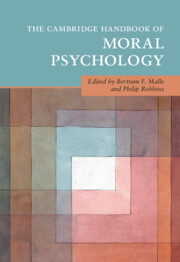Book contents
- The Cambridge Handbook of Moral Psychology
- Cambridge Handbooks in Psychology
- The Cambridge Handbook of Moral Psychology
- Copyright page
- Contents
- Figures
- Tables
- Contributors
- Preface
- 1 Modern Moral Psychology
- Part I Building Blocks
- Part II Thinking and Feeling
- 7 Moral Decision Making
- 8 Are Moral Judgments Rational?
- 9 Moral Categorization and Mind Perception
- 10 Moral Emotions
- 11 The Benefits and Costs of Empathy in Moral Decision Making
- Part III Behavior
- Part IV Origins, Development, and Variation
- Part V Applications and Extensions
- Index
- References
9 - Moral Categorization and Mind Perception
from Part II - Thinking and Feeling
Published online by Cambridge University Press: 20 February 2025
- The Cambridge Handbook of Moral Psychology
- Cambridge Handbooks in Psychology
- The Cambridge Handbook of Moral Psychology
- Copyright page
- Contents
- Figures
- Tables
- Contributors
- Preface
- 1 Modern Moral Psychology
- Part I Building Blocks
- Part II Thinking and Feeling
- 7 Moral Decision Making
- 8 Are Moral Judgments Rational?
- 9 Moral Categorization and Mind Perception
- 10 Moral Emotions
- 11 The Benefits and Costs of Empathy in Moral Decision Making
- Part III Behavior
- Part IV Origins, Development, and Variation
- Part V Applications and Extensions
- Index
- References
Summary
This chapter of the handbook discusses the role of mind perception in the categorization of individuals as moral agents and moral patients. Moral agents are defined as individuals that can commit morally wrong actions; moral patients are defined as individuals that can be morally wronged. It is generally agreed that the attribution of moral agency and moral patiency is linked to the attribution of mental capacities and traits. The chapter surveys a variety of models of mind perception, some of which focus on the representation of mental capacities, some of which focus on the representation of mental traits. The dominant model of mind perception in moral psychology is the experience-agency model, which divides the space of mindedness into experiential capacities like sentience and self-awareness, and agentic capacities like deliberative reasoning and self-control. Reviewing the empirical literature on moral categorization, the author argues that neither the experience-agency model nor any of the major alternatives to it captures all the factors to which everyday attributions of moral agency and moral patiency are sensitive.
Keywords
- Type
- Chapter
- Information
- The Cambridge Handbook of Moral Psychology , pp. 198 - 221Publisher: Cambridge University PressPrint publication year: 2025

